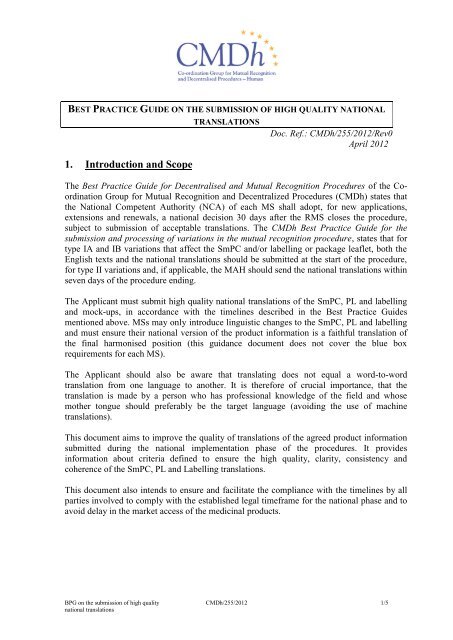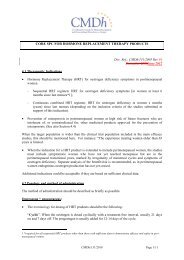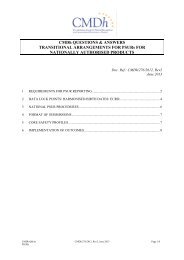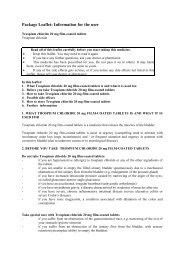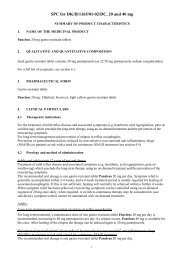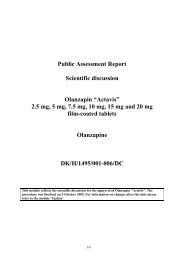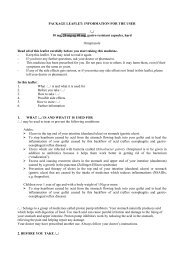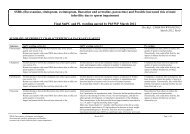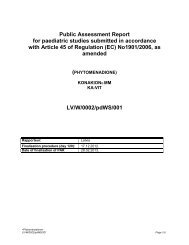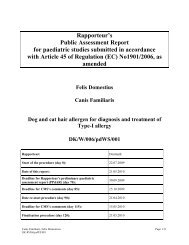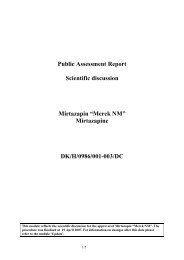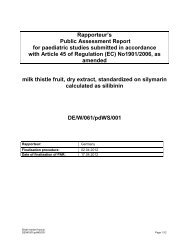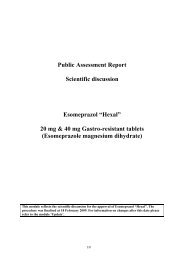CMDh Best Practice Guide for the submission
CMDh Best Practice Guide for the submission
CMDh Best Practice Guide for the submission
You also want an ePaper? Increase the reach of your titles
YUMPU automatically turns print PDFs into web optimized ePapers that Google loves.
BEST PRACTICE GUIDE ON THE SUBMISSION OF HIGH QUALITY NATIONAL<br />
1. Introduction and Scope<br />
TRANSLATIONS<br />
Doc. Ref.: <strong>CMDh</strong>/255/2012/Rev0<br />
April 2012<br />
The <strong>Best</strong> <strong>Practice</strong> <strong>Guide</strong> <strong>for</strong> Decentralised and Mutual Recognition Procedures of <strong>the</strong> Coordination<br />
Group <strong>for</strong> Mutual Recognition and Decentralized Procedures (<strong>CMDh</strong>) states that<br />
<strong>the</strong> National Competent Authority (NCA) of each MS shall adopt, <strong>for</strong> new applications,<br />
extensions and renewals, a national decision 30 days after <strong>the</strong> RMS closes <strong>the</strong> procedure,<br />
subject to <strong>submission</strong> of acceptable translations. The <strong>CMDh</strong> <strong>Best</strong> <strong>Practice</strong> <strong>Guide</strong> <strong>for</strong> <strong>the</strong><br />
<strong>submission</strong> and processing of variations in <strong>the</strong> mutual recognition procedure, states that <strong>for</strong><br />
type IA and IB variations that affect <strong>the</strong> SmPC and/or labelling or package leaflet, both <strong>the</strong><br />
English texts and <strong>the</strong> national translations should be submitted at <strong>the</strong> start of <strong>the</strong> procedure,<br />
<strong>for</strong> type II variations and, if applicable, <strong>the</strong> MAH should send <strong>the</strong> national translations within<br />
seven days of <strong>the</strong> procedure ending.<br />
The Applicant must submit high quality national translations of <strong>the</strong> SmPC, PL and labelling<br />
and mock-ups, in accordance with <strong>the</strong> timelines described in <strong>the</strong> <strong>Best</strong> <strong>Practice</strong> <strong>Guide</strong>s<br />
mentioned above. MSs may only introduce linguistic changes to <strong>the</strong> SmPC, PL and labelling<br />
and must ensure <strong>the</strong>ir national version of <strong>the</strong> product in<strong>for</strong>mation is a faithful translation of<br />
<strong>the</strong> final harmonised position (this guidance document does not cover <strong>the</strong> blue box<br />
requirements <strong>for</strong> each MS).<br />
The Applicant should also be aware that translating does not equal a word-to-word<br />
translation from one language to ano<strong>the</strong>r. It is <strong>the</strong>re<strong>for</strong>e of crucial importance, that <strong>the</strong><br />
translation is made by a person who has professional knowledge of <strong>the</strong> field and whose<br />
mo<strong>the</strong>r tongue should preferably be <strong>the</strong> target language (avoiding <strong>the</strong> use of machine<br />
translations).<br />
This document aims to improve <strong>the</strong> quality of translations of <strong>the</strong> agreed product in<strong>for</strong>mation<br />
submitted during <strong>the</strong> national implementation phase of <strong>the</strong> procedures. It provides<br />
in<strong>for</strong>mation about criteria defined to ensure <strong>the</strong> high quality, clarity, consistency and<br />
coherence of <strong>the</strong> SmPC, PL and Labelling translations.<br />
This document also intends to ensure and facilitate <strong>the</strong> compliance with <strong>the</strong> timelines by all<br />
parties involved to comply with <strong>the</strong> established legal timeframe <strong>for</strong> <strong>the</strong> national phase and to<br />
avoid delay in <strong>the</strong> market access of <strong>the</strong> medicinal products.<br />
BPG on <strong>the</strong> <strong>submission</strong> of high quality <strong>CMDh</strong>/255/2012 1/5<br />
national translations
This guidance must be read toge<strong>the</strong>r with <strong>the</strong><br />
<strong>CMDh</strong> <strong>Best</strong> <strong>Practice</strong> <strong>Guide</strong> <strong>for</strong> <strong>the</strong> Decentralised and <strong>the</strong> Mutual Recognition<br />
Procedure,<br />
<strong>CMDh</strong> <strong>Best</strong> <strong>Practice</strong> <strong>Guide</strong> <strong>for</strong> <strong>the</strong> <strong>submission</strong> and processing of variations in <strong>the</strong><br />
mutual recognition procedure,<br />
EC <strong>Guide</strong>line on <strong>the</strong> Readability of <strong>the</strong> labelling and Package Leaflet of<br />
Medicinal Products <strong>for</strong> Human use, Revision 1, 12 January 2009<br />
National guidance on language specific conditions<br />
2. Criteria taken into account <strong>for</strong> <strong>the</strong> linguistic review of <strong>the</strong> Product<br />
In<strong>for</strong>mation<br />
In accordance with <strong>the</strong> guidance established in <strong>the</strong> <strong>CMDh</strong> <strong>Best</strong> <strong>Practice</strong> <strong>Guide</strong> <strong>for</strong><br />
Decentralised and Mutual Recognition Procedures and <strong>CMDh</strong> <strong>Best</strong> <strong>Practice</strong> <strong>Guide</strong> <strong>for</strong> <strong>the</strong><br />
<strong>submission</strong> and processing of variations in <strong>the</strong> mutual recognition procedure, <strong>the</strong> Applicant<br />
must submit high quality translations of <strong>the</strong> final agreed versions of <strong>the</strong> product in<strong>for</strong>mation.<br />
To guarantee <strong>the</strong> quality of <strong>the</strong> product in<strong>for</strong>mation translation, <strong>the</strong> Applicant should check<br />
all crucial issues ensuring <strong>the</strong>ir compliance, namely a complete national translation with<br />
clear wording and taking into account <strong>the</strong> target group. Specific attention should be given<br />
to spelling, punctuation and o<strong>the</strong>r grammatical aspects taking also into account <strong>the</strong> extent of<br />
editorial and stylistic changes, particularly with <strong>the</strong> rephrasing of <strong>the</strong> texts ensuring that <strong>the</strong><br />
meaning of <strong>the</strong> in<strong>for</strong>mation is clear and comprehensible and in agreement with <strong>the</strong> final<br />
harmonised product in<strong>for</strong>mation.<br />
A correct patient friendly translation of <strong>the</strong> user tested PL is just as important as a high<br />
quality medically correct translation of <strong>the</strong> SmPC. This will often not be achieved by a literal<br />
translation of <strong>the</strong> English text.<br />
The proposed Product In<strong>for</strong>mation should take into account <strong>the</strong> following points:<br />
a) Compliance of <strong>the</strong> translation with <strong>the</strong> final agreed English product in<strong>for</strong>mation;<br />
b) Use of QRD template, country specific national language version;<br />
c) Compliance with specific national requirements regarding specific style sheet of <strong>the</strong><br />
texts of <strong>the</strong> texts;<br />
d) Use of <strong>the</strong> appropriate scientific terminology;<br />
e) Consistency of terminology with o<strong>the</strong>r medicinal products (innovator, generic or<br />
class-similar medicinal products) already approved by <strong>the</strong> NCA;<br />
f) User-friendly terms (<strong>for</strong> PL).<br />
g) National Blue Box requirements.<br />
a) Compliance of <strong>the</strong> translation with <strong>the</strong> final agreed product in<strong>for</strong>mation<br />
The Applicant must ensure a faithful translation of <strong>the</strong> final agreed product in<strong>for</strong>mation<br />
approved at <strong>the</strong> end of <strong>the</strong> European phase of <strong>the</strong> procedure, avoiding omissions and/or<br />
addition of sentences, terms or paragraphs. This is in particularly important when <strong>the</strong><br />
translation is updated concurrently with <strong>the</strong> assessment done during <strong>the</strong> procedure.<br />
BPG on <strong>the</strong> <strong>submission</strong> of high quality <strong>CMDh</strong>/255/2012 2/5<br />
national translations
All manufacturer(s) responsible <strong>for</strong> batch release that are listed in <strong>the</strong> final English PL<br />
should be included in <strong>the</strong> national translation (regarding <strong>the</strong> requirements <strong>for</strong> <strong>the</strong> printed<br />
package leaflet see http://www.hma.eu/126.html.<br />
b) Use of QRD template, country specific national language version<br />
The submitted translations must ensure that <strong>the</strong> latest approved QRD template version (as<br />
completed by <strong>the</strong> RMS) and its appendixes are used. There<strong>for</strong>e, <strong>the</strong> Applicant should not use<br />
different titles, subtitles and sentences from those stated on current QRD template and its<br />
appendixes.<br />
The current QRD template is available at:<br />
http://www.hma.eu/126.html<br />
http://www.ema.europa.eu/ema/index.jsp?curl=pages/regulation/document_listing/docu<br />
ment_listing_000134.jsp&mid=WC0b01ac0580022c59&jsenabled=true<br />
c) Compliance with specific national requirements regarding specific style sheet of <strong>the</strong><br />
texts<br />
The Applicant must ensure that <strong>the</strong> national requirements are met <strong>for</strong> specific style sheet of<br />
<strong>the</strong> texts (type and font size, paragraphs, tabs, header and footer, etc.) of <strong>the</strong> product<br />
in<strong>for</strong>mation. Specific in<strong>for</strong>mation on this should be checked in <strong>the</strong> national websites. If not<br />
stated o<strong>the</strong>rwise, <strong>the</strong> requirements of <strong>the</strong> Readability <strong>Guide</strong>line should be followed:<br />
http://ec.europa.eu/health/files/eudralex/vol-<br />
2/c/2009_01_12_readability_guideline_final_en.pdf<br />
No changes to <strong>the</strong> wording of <strong>the</strong> agreed product in<strong>for</strong>mation are allowed.<br />
d) Use of <strong>the</strong> appropriate scientific terminology<br />
The scientific terms used in <strong>the</strong> translation of <strong>the</strong> product in<strong>for</strong>mation should be carefully<br />
checked. There<strong>for</strong>e, <strong>the</strong> Applicant should use appropriate scientific terminology and take into<br />
account that if a standard statement is used in <strong>the</strong> English text, a standard translation should<br />
be used, namely:<br />
1) In all sections where reference is made to <strong>the</strong> pharmaceutical <strong>for</strong>m, <strong>the</strong> standard term<br />
according to <strong>the</strong> EDQM should be used (current version of <strong>the</strong> Standard Terms –<br />
European Pharmacopoeia);<br />
2) The in<strong>for</strong>mation in <strong>the</strong> SmPC, Section 4.6 ‘Fertility, pregnancy and lactation’ should<br />
comply with “Statement <strong>for</strong> use in Section 4.6 ‘Pregnancy and lactation’ of SmPC”<br />
(available in Appendix I of <strong>the</strong> QRD template)<br />
3) The in<strong>for</strong>mation in <strong>the</strong> SmPC, Section 4.8 “Undesirable effects” should comply with<br />
<strong>the</strong> MedDRA terminology (available in Appendix II of <strong>the</strong> QRD template);<br />
4) The in<strong>for</strong>mation in <strong>the</strong> SmPC, Section 6.4 “Special precautions <strong>for</strong> storage” should<br />
comply with <strong>the</strong> Storage condition statements (available in Appendix III of <strong>the</strong> QRD<br />
template);<br />
5) The in<strong>for</strong>mation regarding Batch number and Expiry date should comply with<br />
Appendix IV of <strong>the</strong> QRD template<br />
BPG on <strong>the</strong> <strong>submission</strong> of high quality <strong>CMDh</strong>/255/2012 3/5<br />
national translations
6) With regard to <strong>the</strong> active substances and excipients, <strong>the</strong>ir naming should always be<br />
that used <strong>for</strong> national designation according to <strong>the</strong> [National] Pharmacopoeia or o<strong>the</strong>r<br />
relevant standard published by NCA, where applicable;<br />
7) The warning statements relating to <strong>the</strong> presence of certain excipients in medicinal<br />
products should comply with <strong>the</strong> country specific national language version of <strong>the</strong><br />
<strong>Guide</strong>line “Excipients in <strong>the</strong> label and package leaflet of medicinal products <strong>for</strong><br />
human use.<br />
http://www.ema.europa.eu/ema/index.jsp?curl=pages/regulation/document_listing/do<br />
cument_listing_000254.jsp&mid=WC0b01ac058008c34c&jsenabled=true<br />
8) In all sections where reference is made to <strong>the</strong> routes of administration and primary<br />
packages, <strong>the</strong> standard terms in accordance with <strong>the</strong> EDQM should be used (current<br />
version of <strong>the</strong> Standard Terms – European Pharmacopoeia);<br />
9) The applicant must ensure that country specific guidance regarding Braille<br />
implementation is taken into account.<br />
e) Consistency of terminology with o<strong>the</strong>r medicinal products (innovator, generic or<br />
class-similar medicinal products) already approved<br />
The Applicant should take into account <strong>the</strong> terminology already approved by <strong>the</strong> NCA <strong>for</strong> <strong>the</strong><br />
reference medicinal product or a medicinal product with <strong>the</strong> same active substance or from<br />
<strong>the</strong> same <strong>the</strong>rapeutic class. National translations of <strong>the</strong> PhVWP recommendation or <strong>the</strong> texts<br />
agreed <strong>for</strong> Art. 45/46 Paediatric worksharing published on <strong>the</strong> NCA website should be used<br />
<strong>for</strong> translations, if available.<br />
Additionally, it should be noted that <strong>for</strong> generic applications to Centrally Authorised<br />
Products <strong>the</strong> applicant should preferably use <strong>the</strong> national wording from <strong>the</strong> centrally<br />
approved product in all relevant sections of <strong>the</strong> SmPC and PL.<br />
Fur<strong>the</strong>rmore, generics implementing <strong>the</strong> wording of an article 30 Commission Decision <strong>for</strong><br />
<strong>the</strong> innovator product should comply with <strong>the</strong> national translation published in <strong>the</strong><br />
Community Register:<br />
http://ec.europa.eu/health/documents/community-register/html/refh_o<strong>the</strong>rs.htm<br />
Where <strong>the</strong> existence of usage patent(s) leads to differences in <strong>the</strong> product in<strong>for</strong>mation<br />
compared to <strong>the</strong> reference medicinal product, this should be indicated accordingly when<br />
submitting <strong>the</strong> national translations.<br />
f) User-friendly terms (<strong>for</strong> PL)<br />
It is recommended that <strong>the</strong> package leaflet should be written in a language understandable by<br />
<strong>the</strong> patient and should reflect <strong>the</strong> terminology <strong>the</strong> patient is likely to be familiar with.<br />
Additionally, it should be kept in mind that <strong>the</strong> PL is user tested and <strong>the</strong> Applicant should<br />
ensure that <strong>the</strong> terminology used in <strong>the</strong> national translations of <strong>the</strong> user tested PL is userfriendly<br />
and appropriate to <strong>the</strong> target patient groups.<br />
g) National Blue Box requirements<br />
The Applicant must ensure that all national blue box requirements are taken into account.<br />
3. Process of reviewing <strong>the</strong> translations<br />
BPG on <strong>the</strong> <strong>submission</strong> of high quality <strong>CMDh</strong>/255/2012 4/5<br />
national translations
The Applicant must submit, to all MS involved in <strong>the</strong> procedure, high quality national<br />
translations of <strong>the</strong> SmPC, PL and Labelling and mock-ups, if necessary, according to <strong>the</strong><br />
<strong>CMDh</strong> <strong>Best</strong> <strong>Practice</strong> <strong>Guide</strong> <strong>for</strong> <strong>the</strong> Decentralised and <strong>the</strong> Mutual Recognition Procedure and<br />
<strong>the</strong> <strong>CMDh</strong> <strong>Best</strong> <strong>Practice</strong> <strong>Guide</strong> <strong>for</strong> <strong>the</strong> <strong>submission</strong> and processing of variations in <strong>the</strong> mutual<br />
recognition procedure. Final English texts circulated by <strong>the</strong> RMS and not <strong>the</strong> texts from <strong>the</strong><br />
earlier phases of <strong>the</strong> procedure must be used <strong>for</strong> <strong>the</strong> national translations.<br />
Marketing Authorisation Applicants or Marketing Authorisation Holders are advised to take<br />
into account <strong>the</strong> criteria defined above in Section 2. Any deviation to <strong>the</strong> principles identified<br />
should be avoided.<br />
When planning a multilingual package, Applicants should carefully consider <strong>the</strong> translation,<br />
particularly concerning labelling and PL, taking into account <strong>the</strong> need to harmonise <strong>the</strong><br />
relevant translations <strong>for</strong> a multilingual package.<br />
The NCA should review <strong>the</strong> received national translations and grant national marketing<br />
authorisation within 30 days after <strong>the</strong> receipt, if no inaccuracies are found.<br />
In case <strong>the</strong> quality of <strong>the</strong> national translations is not acceptable, <strong>the</strong> NCA will in<strong>for</strong>m <strong>the</strong><br />
Applicant of <strong>the</strong> identified deficiencies and request <strong>the</strong> Applicant to address <strong>the</strong>se and<br />
resubmit updated national translations. No tracked change version by <strong>the</strong> NCA will be<br />
prepared in this case.<br />
Alternatively, <strong>the</strong> NCA will review <strong>the</strong> translations submitted and notify <strong>the</strong> Applicant of<br />
necessary corrections in a tracked-change version.<br />
The Applicant should accept <strong>the</strong> tracked changes or justify <strong>the</strong> non-acceptance, and submit to<br />
<strong>the</strong> NCA <strong>the</strong> final versions of <strong>the</strong> product in<strong>for</strong>mation. Within this reviewing process, <strong>the</strong><br />
Applicants should meet <strong>the</strong>ir deadlines <strong>for</strong> <strong>the</strong> agreement on <strong>the</strong> product in<strong>for</strong>mation in<br />
accordance with each NCA guidance.<br />
The legal timeframe <strong>for</strong> <strong>the</strong> finalisation of <strong>the</strong> procedure in <strong>the</strong> national phase is suspended<br />
whenever a request <strong>for</strong> re<strong>submission</strong> of <strong>the</strong> product in<strong>for</strong>mation is made and whenever <strong>the</strong><br />
Applicant is requested to address <strong>the</strong> inaccuracies found.<br />
4. Multiple applications<br />
Specific national guidance on finalisation of multiple applications should be followed. Some<br />
MS advice <strong>the</strong> Applicant to provide a single contact <strong>for</strong> <strong>the</strong> simultaneous <strong>submission</strong> of <strong>the</strong><br />
product in<strong>for</strong>mation translations and of all relevent documentation to <strong>the</strong> finalisation of<br />
multiple applications, in order to streamline <strong>the</strong> revision of <strong>the</strong> texts as well as <strong>the</strong> granting of<br />
<strong>the</strong> MA. The granting of a duplicate MA, in this case, should occur simultaneously in order<br />
to make all <strong>the</strong> resources involved more efficient and ensure equity on MA granting <strong>for</strong> every<br />
duplicate applications.<br />
BPG on <strong>the</strong> <strong>submission</strong> of high quality <strong>CMDh</strong>/255/2012 5/5<br />
national translations


